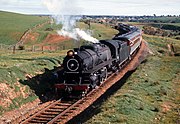|
South Australian Railways 700 class (steam)
The South Australian Railways 700 class was a class of 2-8-2 steam locomotives operated by the South Australian Railways. HistoryDeliveryAs part of William Webb's rehabilitation of the South Australian Railways, ten 2-8-2 steam locomotives were delivered by Armstrong Whitworth, Newcastle upon Tyne in 1926. They were designed to be able to operate across broad gauge branch lines laid with 60lbs rail. The first locomotive, 700 arrived at Port Adelaide via ship in March 1926.[1] 700 operated for the first time in April 1926 on a trial run north of Adelaide.[2] It was involved in a minor collision when it rear-ended a freight train in May 1926 between Upper Sturt and Mount Lofty.[3] In June 1926, it entered regular service between Adelaide and Murray Bridge, and the 9 remaining 700s were delivered that same month. [4] The 700s were more common on freight trains but they also hauled passenger trains. In 1927, 706 had its original trailing bogie replaced with a cast 'Delta' bogie, and it incorporated a booster.[5] In 1928, the 700s were followed by ten nearly identical 710 class locomotives built at Islington Railway Workshops, which were built with boosters as previously installed on 706.[6] Track RestrictionsIn 1931, 700 and 710 class locomotives with boosters, including 706 were banned from 60lb laid lines because of the weight of the boosters. 706 and a few 710s had their boosters removed so they could operate on 60lb lines, as the 720 class locomotives were banned from operating on 60lb lines and so there were not enough larger locomotives to operate on them. The 700s and 710s faced increasing restrictions on speed, coal and water on 60lb lines during the 1930s. They were eventually barred from operating on the Pinnaroo and Barmera lines, but were allowed again in later years. They were also allowed to operate on the Outer Harbor, Port Dock, and Semaphore lines following platform widening to provide sufficient space for Redhen railcars. However, the gap was not sufficient to allow the 700s to run at track speed past the platforms and so they were subject to severe speed restrictions.[4] ModificationsThe 700s had minor modifications made early in their operational life to address excessive axle loads and hot bearings. Some other modifications made across the whole class include the replacement of the sand domes with larger ones, the addition of blowdown mufflers in the 1930s, the replacement of the flanged smokestacks with tapered smokestacks, and the relocation of the turbo generators. Some 700s had their single-stage air compressors replaced with single cross-compound pumps.[4] The locomotives were delivered in an all-black livery, but were outshopped with red buffer beams and red lining after the retirement of William Webb. The red lining was quickly covered by the weathering that the locomotives accumulated in service. 706 was damaged in a head-on collision with another train at Snowtown in 1945.[7] It returned to service with a significantly altered front appearance. The changes included a centre-mounted headlight, a numberplate below the headlight and a replacement pressed-steel pilot instead of the original lattice pilot delivered with Webb locomotives. For a short period of time it had a fabricated smokestack similar to the style seen on the 740 class locomotives but later received the standard tapered smokestack. Coal shortages after World War II saw a number converted to burn oil, and some were converted to burn a mixture of coal and oil. Most were later converted back to coal burners, with the exception of 708. Coal pushers were also installed on some locomotives. All had their buffers removed in the 1940s following the changeover to automatic couplers in South Australia.[4] Withdrawal and PreservationThe first two were withdrawn in June 1959 with the remainder replaced as 830 diesel locomotives entered service. Class leader 700 was the last in service, being withdrawn after a series of farewell tours named 'Sayonara Mikado', which occurred across the weekend of 1-2 June, 1968. 700 hauled the first 'Sayonara Mikado' trip which went to Angaston, and ended up joining the second trip with 718 to Victor Harbor to cover for a failed Rx224. [8] The 2 locomotives double-headed back to Adelaide, hours behind schedule due to 718 derailing on the Victor Harbor turntable, and were withdrawn from service after arriving in the early hours of 3 June. [9][10] [11] The National Railway Museum, Port Adelaide has preserved 702. It was originally moved to the Mile End Railway Museum in June 1965, before moving to the current museum site at Port Adelaide in 1988. [12] [13] Class list
Gallery
ReferencesWikimedia Commons has media related to South Australian Railways 700 class (steam).
|
||||||||||||||||||||||||||||||||||||||||||||||||||||||||||||||||||||||||||||||||||||||||||||||||||||||||||||||||||||||||||||||||||||||||||||||||||||||||||






